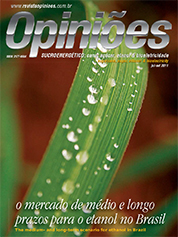Paulo Roberto Gallo
Director of Authomathika Sistemas de Controle
Op-AA-29
Time to improve the corporate environment in Brazil
After having been of service, for almost thirty years, to what is nowadays called the sugarcane-based energy industry, I face the challenge proposed by Revista Opiniões – to, in this space, try to lay out a prognosis on this market, in a medium- to long-term timeline. The first word that comes to mind in this case is: uncertainty.
Much has been said in recent months about the immense market potential of ethanol (anhydrous and hydrated), both domestically and internationally. The most optimistic predictions reach billion of reais figures in terms of investments, along with the need for hundreds of new greenfield projects, as well as the expansion of existing units.
Such perspectives are based on the premise that there is constant growth of the “flex fuel” vehicle fleet in the domestic market, and hence, the increase in demand for hydrated ethanol. The very growth of the vehicle fleet that runs on gasoline, in the Brazilian case would also tend to increase demand for anhydrous ethanol, which, by law, must be added to gasoline in the proportion of 18 to 25% of the total volume.
At first sight, this is a scenario entailing exceptional opportunities for suppliers of products and services to the industry. However, over the decades, we have customarily seen the market vary between highs and lows at an alarming frequency.
During the last “virtuous cycle”, prior to the financial crisis at the end of 2008, the industry was growing at breathtaking rates, with countless new projects – signaling a new phase for the segment, with consolidations taking place and new players entering the business environment.
During this boom phase, the limitations became evident, both of the production sector, unable to meet the demand in terms of quantity and delivery schedules as then required, and as concerning other agents involved – investors per se and governments.
In the last cycle, huge expectation resulted from the potential demand for ethanol, that supposedly would be fostered by increased domestic consumption, but also (and perhaps mainly) by the increase in demand from abroad, resulting from possible programs to add ethanol to gasoline in several countries, on account of environmental impacts and mitigation of greenhouse gas emissions.
In practice, what one saw was a wrong demand estimate. Even worse: if foreign demand had actually grown, there would have been severe problems with the production of raw material and the logistics to ship ethanol to markets abroad.
Surprisingly, following the peak of the 2009 crisis, domestic ethanol demand remained high, thanks to government incentives to foster the automobile industry, which, in combination with external factors that increased the price of sugar, brought about an unrestrained increase in ethanol prices that, until then, hardly covered the production cost, given that the number of new mills that came on stream flooded the market with a huge ethanol surplus.
Nowadays, looking ahead, a machinery or service supplier is faced with a difficult decision: expand production capacity, investing in equipment and human resources, so as to be prepared for possible opportunities that may arise, or remain in the current position, running the risk of not taking advantage of such opportunities? If there were to be strong investment resumption in the industry would it be temporary or long-lasting? Would it be just another bubble or a sustained movement?
If the industry’s development should be sustainable (let us hope it will be), it would be immediately necessary to think about the urgent challenges ahead, requiring actions in the very short-term, with results that are not always quick: How to prevent excessive imbalances between supply and demand? How to finance regulatory inventories? How would one provide qualified labor to suppliers of machinery, equipment and services, and at the same time for operating one’s own industrial plants? How to deal with outdated labor legislation conceived after WW II, which has not been updated as it should have been? How should one proceed to adapt the huge tax burden applicable to mercantile operations in this and in other industries, reducing it to less predatory levels?
World Bank studies realized in a universe of 183 countries only rank Brazil in the 127th place in terms of the facility to do business – i.e., it is safer to do business in 126 countries of a total of 183 than it is in Brazil. Certainly, solutions applied to the sugarcane-based energy industry may no doubt also benefit all other economic segments of Brazil.
Without far-reaching structural reforms, I fear we may not be able to expand strategically important economic areas for Brazil, such as the sugarcane-based energy industry.
In general, it still seems to be difficult for those in power to understand the urgent need to facilitate life of whoever wants to perform entrepreneurial activities, work, produce, and generate and distribute wealth. In 2010, data of IBPT (Brazilian Tax Planning Institute) showed that, since the promulgation of the current Federal Constitution, in 1988, more than 249,000 tax rules were established in Brazil, in addition to approximately 3,400 legal norms that companies must abide by.
Such numbers reflect the difficulty to create and maintain sustainable businesses in Brazil. If the ethanol business should really expand as expected, the biggest challenge may possibly not be to prepare companies to meet the demand for equipment and services. The biggest challenge may be how to overcome the hostile environment for entrepreneurship currently prevailing in Brazil.




